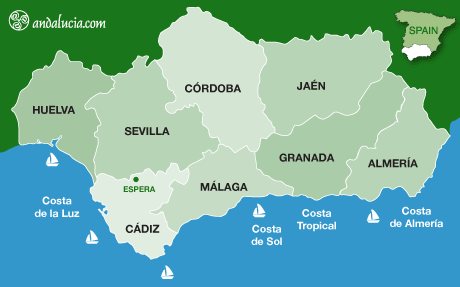This town in the Sierra de Cadiz, near Arcos de la Fontera, is part of the Ruta de Pueblos Blancos (the White Towns Route). It has its own 400-hectare nature reserve - the Reserva Natural del Complejo Endorréico de Espera is made up of three lakes, and is famous for its abundance of rare waterfowl - specifically, coots and ducks. Migrating birds, such as flamingos and storks, also stop here. In addition, you can see foxes, rabbits, hares, tortoises and lizards.
Like many towns in this area, it has a long and rich history stretching back millenia, with two Roman /history/romans.htm ruins, Carissa Aurelia and Esperilla. Carissa is located 7km from Espera, and was originally near a Roman town called Urcia; it includes a burial ground with over 100 tombs, including caves and various funeral monuments, as well as some Neolithic remains. Esperilla is closer to the town, just 1km away; here, you can see houses, town walls and water storage tanks. EsperaÂ’s archaeological museum, which focuses on Hispano-Roman funeral rites, also features statues found at the Esperilla - five lions, a pig, a deer, a warrior and a lady - as well as pottery and axes.
Espera - Hotels
Book hotels in Espera
The 13th-century castle is set above the village, on the Fatetar mountain, which gives it its name. The only intact part is the 16th-century Ermita de Santiago. You can also find a working 18th-century olive oil mill, the Molino de los Diezmos, which is also used for storing flour. Look out for the church of Santa Maria de Gracia, rebuilt after the 1755 Lisbon earthquake.
You can hike to the Roman ruins at Carissa Aurelia and the nature reserve.
Local food products are its own olive oil, pressed in the townÂ’s own molino, and molletes, soft bread rolls, while dishes feature pork products, as well as seasonal offerings such as the fine green asparagus known as esparragos trigueros, and caracoles (snails).
Traditional Espera handicrafts include botos, small leather bottles for storing wine, oil or water.
The town’s fiestas include Santo Cristo de la Antigua, when the patron saint is carried down from the castle to the church, during the week starting on the first Sunday of September. Carnaval (February/March) is celebrated with choriza, as this spicy sausage is known in Espera. Espereños also celebrate the Cruz de Mayo festival (end of April/beginning of May), while the Romeria de San Bernardino is on the second Sunday in May. Christmas celebrations include a belen viviente (live Nativity scene) and the Maraton del Pavo, after Reyes at the beginning of January.
How to get there
Espera is 78km north-east of Cadiz – take the AP4 towards Jerez, then take the A382 heading for Arcos, signposted Circuito de Velocidad (race track), and carry on until you get to the Arcos reservoir. Then take the A393 to Espera.
